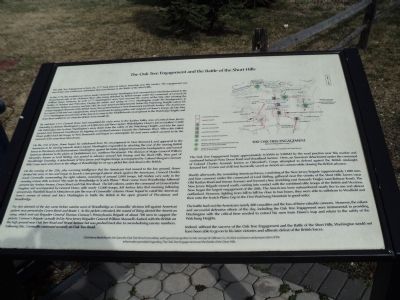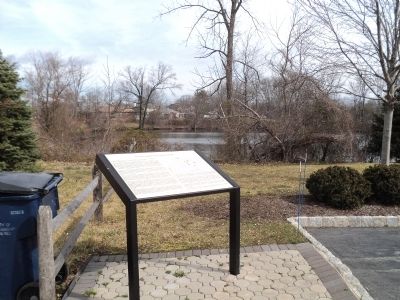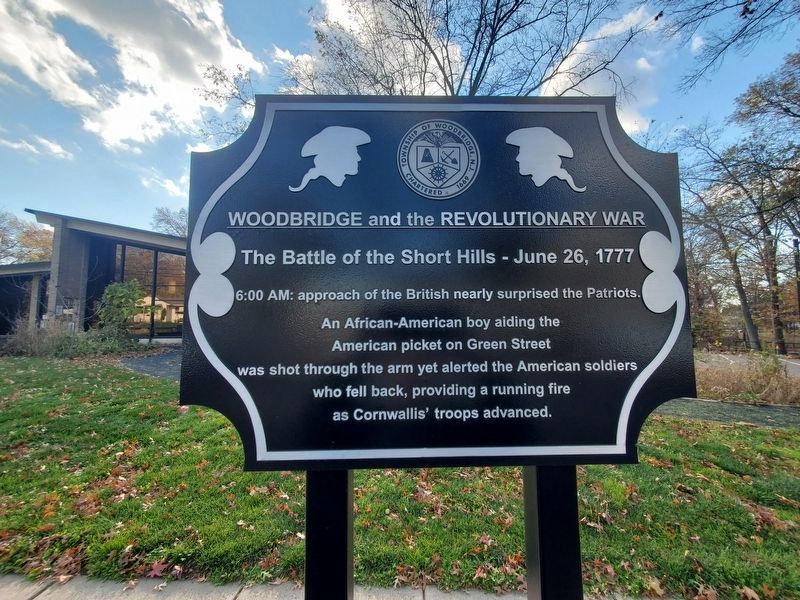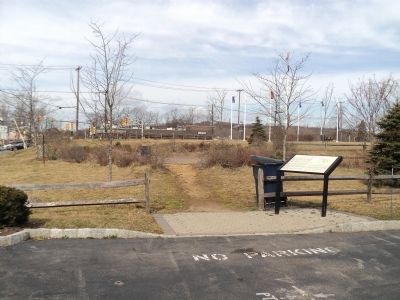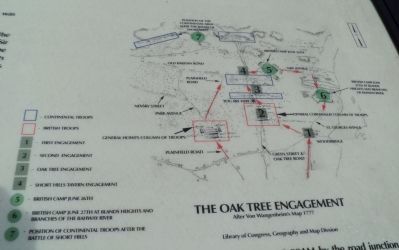Edison in Middlesex County, New Jersey — The American Northeast (Mid-Atlantic)
The Oak Tree Engagement and the Battle of the Short Hills
Inscription.
The Oak Tree Engagement of June 26, 1777 took place in Edison Township near this marker. The engagement was one of four near continuous skirmishes that were known as the Battle of the Short Hills.
In late 1776, the revolutionary forces under General George Washington had retreated from Manhattan Island to the Pennsylvania side of the Delaware River after being defeated by British troops under the command of General Sir William Howe. However, by early 1777, Washington’s army had reversed the course of the War after winning the battles of Trenton and Princeton. During the winter and spring of 1777, Washington made his headquarters in Morristown. Between January and late May, he sent American detachments below the Watchung Heights where his troops engaged elements of the British Army, then posted between New Brunswick and Perth Amboy. The Americans, in a series of hit-and-run engagements, struck numerous foraging parties and outposts of Howe’s troops. By late May 1777, Washington moved most of the American army to the Middlebrook encampment in the Watchung Heights and from there waited to see what the British Army would do.
By mid-June 1777, General Howe had assembled his main army in the Raritan Valley area of central New Jersey. Intending to destroy Washington’s army of 8,000 men and then capture Philadelphia, Howe’s forces totaled 17,000. His initial plan was to draw Washington’s army down from the safety of the Watchung Heights and into the open ground near Somerset Courthouse by feigning an overland advance towards the Delaware River. When this failed, Howe pulled back his troops to New Brunswick and began to contemplate his next move which seemed to be the removal of his army from New Jersey.
On the 21st of June, Howe began his withdrawal from his encampment in New Brunswick and appeared to the Americans to be moving towards Staten Island. Washington responded by attacking the rear of the moving British forces in Piscataway and Bonhamtown. Washington, against his better judgment moved his headquarters and several American divisions to the plains at Quibbletown (i.e., northern Piscataway). The division of Major General William Alexander, known as Lord Stirling, was posted in advance around Ash Swamp and the Short Hills, then part of Woodbridge Township. A detachment of New Jersey and Virginia troops accompanied by Colonel Morgan’s famous Rifle Corps were sent closer to the village of Woodbridge to set up a picket line and observe the British.
On the evening of the 25th, after receiving intelligence that the Americans had moved to the low ground, Howe divided his army in two and began to launch two-pronged pincer attack against the Americans. General Charles (Lord) Cornwallis
commanding the right column, consisting of around 5,000 troops, left Amboy very early in the morning of June 26th, to travel “the route by Woodbridge to Scotch Plains.” Their course from Woodbridge followed present-day Plainfield Road in Metuchen to join the rear of Cornwallis’ column. Howe hoped to cutoff the American Army’s avenue of retreat and force Washington to battle the British in the open ground of Piscataway and Woodbridge.
The first skirmish of the day came before sunrise west of Woodbridge as Cornwallis’ division fell against American pickets near present-day Green Street and Route 1. As the pickets retreated, the sound of firing alerted the American camp, which sent out Brigadier General Thomas Conway’s Pennsylvania Brigade of about 700 men to support the pickets. Conway’s Brigade (actually led by New Jersey Brigadier General William Maxwell) clashed with the British on the high ground near Oak Tree Road and Wood Avenue but was pushed back due to overwhelming enemy numbers. Following this, Cornwallis continued westerly on Oak Tree Road.
The Oak Tree Engagement began approximately 8:30AM to 9:00AM by the road junction near this marker and continued between New Dover Road and Woodland Avenue. Here, an American detachment under the command of Colonel Charles Armand, known as Ottendorf’s Corps attempted to defend against the British onslaught. Armand lost
32 men out of 80 but heroically saved an American cannon while slowing the British advance.
Shortly afterwards, the remaining American forces, consisting of the New Jersey Brigade (approximately 1,000 men and four cannons) under the command of Lord Stirling, gathered near the vicinity of the Short Hills Tavern (near Old Raritan Road and Inman Avenue) and formed a line stretching east (towards Tingley Lane/Rahway Road). The New Jersey Brigade moved south, coming into contact with the combined elite troops of the British and Hessians. Now began the largest engagement of the 26th. The Americans were outnumbered nearly five to one and almost outflanked. However, fighting from hill to hill for close to two hours, they were able to withdraw to Westfield and then onto the Scotch Plains Gap in the First Watchung Mountain in good order.
The battle had cost the Americans nearly 200 casualties and the loss of three valuable cannons. However, the valiant and successful defensive efforts of the day, including the Oak Tree Engagement were instrumental in providing Washington with the critical time needed to extract his men from Howe’s trap and return to the safety of the Watchung Heights.
Indeed, without the success of the Oak Tree Engagement and the Battle of the Short Hills, Washington would not have been able to go on to his later victories and ultimate defeat of the British forces.
Erected by Woodbridge Township Historic Preservation Commission.
Topics. This historical marker is listed in this topic list: War, US Revolutionary. A significant historical date for this entry is June 26, 1777.
Location. 40° 34.558′ N, 74° 22.551′ W. Marker is in Edison, New Jersey, in Middlesex County. Marker is at the intersection of Oak Tree Avenue and North Dover Road on Oak Tree Avenue. The marker is located in Oak Tree Pond Park. Touch for map. Marker is in this post office area: Edison NJ 08820, United States of America. Touch for directions.
Other nearby markers. At least 8 other markers are within 3 miles of this marker, measured as the crow flies. The Reuben Ayers House (within shouting distance of this marker); Oak Tree Pond (within shouting distance of this marker); The Oak Tree Neighborhood (about 300 feet away, measured in a direct line); Police Athletic League Memorial Field (approx. 1.7 miles away); Quaker Meeting House (approx. 1.7 miles away); First Baptist Church of South Plainfield (approx. 1.9 miles away); Thomas Edison and the Electric Railway (approx. 2.1 miles away); Thomas Alva Edison’s Menlo Park Invention Factory (approx. 2.1 miles away). Touch for a list and map of all markers in Edison.
More about this marker. A battle map of the Oak Tree Engagement appears at the upper right of the marker. It indicated the location of the marker, as well as the positions of the Continental and British troops; the First Engagement; Second Engagement; Oak Tree Engagement; Short Hills Tavern Engagement; British Camp on June 26th; British Camp on June 27th at Blands Heights and branches of the Rahway River; and Position of Continental Troops after the Battle of Short Hills.
Credits. This page was last revised on January 9, 2023. It was originally submitted on March 9, 2012, by Bill Coughlin of Woodland Park, New Jersey. This page has been viewed 1,726 times since then and 75 times this year. Last updated on January 2, 2023, by John A. Lande of Woodbridge, New Jersey. Photos: 1, 2. submitted on March 9, 2012, by Bill Coughlin of Woodland Park, New Jersey. 3. submitted on January 2, 2023, by John A. Lande of Woodbridge, New Jersey. 4, 5. submitted on March 9, 2012, by Bill Coughlin of Woodland Park, New Jersey. • J. Makali Bruton was the editor who published this page.
